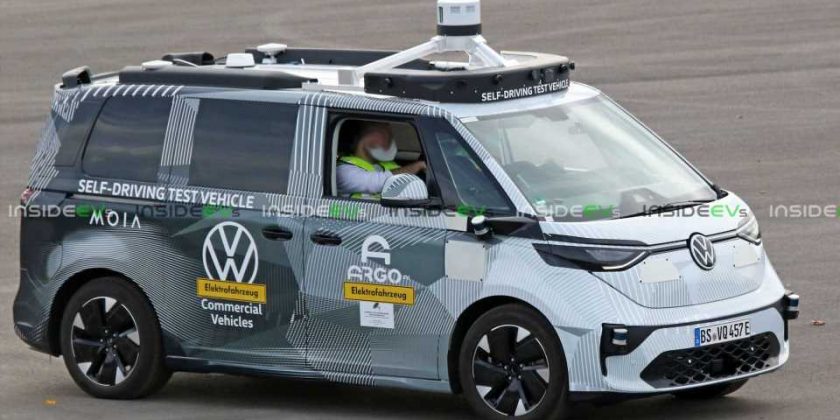Volkswagen is visibly excited to present the production version of the ID Buzz concept to the world. The all-electric commercial vehicle or people carrier even made an unexpected cameo in VW’s presentation for the ID.5 electric coupe-like crossover, even though the presentation was not about it.
The vehicle shown next to the ID.5 looks like it is a camouflaged prototype, so it probably won’t change for production. What will be different, at least depending on trim level, will be the headlights – whereas the vehicle from the presentation has very cool looking lights that wouldn’t look out of place on a concept, our spies recently spied another prototype with more simple lights.
What our spies saw was just a Buzz testbed for self-driving tech, but that particular prototype also had simpler headlights, of the kind you will get on an entry-level car. And the fact that it had an entire roof-mounted array of sensors for autonomous driving hints at the fact that the finished vehicle will eventually feature advanced self-driving features – VW wants the Buzz to drive itself by 2025.
Our spies also point out that the vehicle used to test the autonomous tech is a real pre-production model, complete with production bumpers, lights, mirrors, doors and even a full interior. They were able to take a shot of the interior and, no surprises here, it shares its steering wheel, screens and gear selector with other ID-badged models. They are positioned differently and you will sit higher in the Buzz, but most of the kit will be shared.
Gallery: VW ID.Buzz Self-Driving Prototype Spy Photos
Thanks to this batch of photos we were also able to see where the charging port is – on the rear right of the vehicle – as well as some of the rear light design too. There’s a strong chance that a full-width light bar may be hiding under the camouflage, or two strips meeting in the middle right above the badge.
When it comes to the Buzz’s specs, VW has officially confirmed it will feature battery sizes from 48 kWh to 111 kWh, bigger than any other vehicle built on the MEB platform, and with the biggest pack the WLTP range will be 550 km (314 miles). Rear- and all-wheel drive variants will be on offer once the vehicle goes into production sometime in 2022.
Source: Read Full Article








